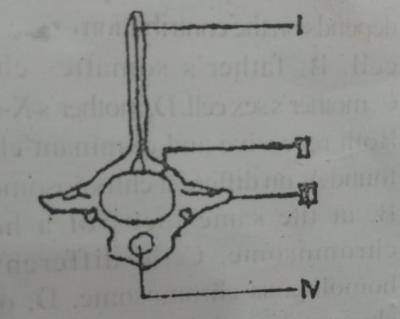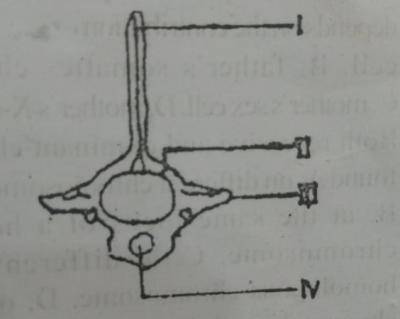Year :
2020
Title :
Biology
Exam :
JAMB Exam
Paper 1 | Objectives
11 - 20 of 40 Questions
| # | Question | Ans |
|---|---|---|
| 11. |
What is the term used to describe biotic and abiotic factors in the environment of the organism? A. habitat B. biome C. ecosystem D. ecological niche Detailed SolutionAn ecosystem consists of all the biotic and abiotic factors that influence that community.There is an explanation video available below. |
|
| 12. |
Which of the following instruments is NOT used in measuring abiotic factors in any habitat? A. microscope B. thermometer C. hygrometer D. windvane Detailed SolutionCommon abiotic factors are atmosphere, chemical elements, sunlight/temperature, wind and water, all other options are instrument used to measure these apart from microscope which can be used to observe small objects, even cells.There is an explanation video available below. |
|
| 13. |
The smallest living organism which share the characteristics of both living and non-living matter are A. bacteria B. fungi C. viruses D. protozoa |
|
| 14. |
The process by which a red blood cell placed in distilled water absorbs water until it burst and realease it's content into the surrounding is known as A. osmosis B. plasmolysis C. turgidity D. hemolysis Detailed SolutionYour body normally destroys old or faulty red blood cells in the spleen or other parts of your body through a process called hemolysisThere is an explanation video available below. |
|
| 15. |
Which of the following waste products in plants is excreted through the stomata and lenticles? A. carbon dioxide B. alkaloids C. tannins D. anthoocyanins Detailed SolutionThe waste products of a plant are carbon dioxide, water vapour and oxygen.There is an explanation video available below. |
|
| 16. |
 Use the diagram to answer the question A. lumber B. thoracic C. caudal D. cervical |
|
| 17. |
 Use the diagram to answer the question A. i B. ii C. iii D. iv |
|
| 18. |
The excretory structure in the earthworm is the A. malphighian tubule B. flame cell C. nephridium D. kidney Detailed SolutionNephridia remove metabolic wastes from an animal's body. Nephridia come in two basic categories: metanephridia and protonephridia.There is an explanation video available below. |
|
| 19. |
In which of the following vertebrates does the skin function as a respiratory surface A. rat B. lizard C. fish D. frog Detailed SolutionAmphibians utilize gills for breathing early in life, and develop primitive lungs in their adult life; additionally, they are able to breathe through their skin.There is an explanation video available below. |
|
| 20. |
The process of walking is under the control of the part of the brain called A. optic lobe B. olfactory lobe C. cerebellum D. medulla oblongata Detailed SolutionCoordination of voluntary movements. Most movements are composed of a number of different muscle groups acting together in a temporally coordinated fashion. One major function of the cerebellum is to coordinate the timing and force of these different muscle groups to produce fluid limb or body movements.There is an explanation video available below. |
| 11. |
What is the term used to describe biotic and abiotic factors in the environment of the organism? A. habitat B. biome C. ecosystem D. ecological niche Detailed SolutionAn ecosystem consists of all the biotic and abiotic factors that influence that community.There is an explanation video available below. |
|
| 12. |
Which of the following instruments is NOT used in measuring abiotic factors in any habitat? A. microscope B. thermometer C. hygrometer D. windvane Detailed SolutionCommon abiotic factors are atmosphere, chemical elements, sunlight/temperature, wind and water, all other options are instrument used to measure these apart from microscope which can be used to observe small objects, even cells.There is an explanation video available below. |
|
| 13. |
The smallest living organism which share the characteristics of both living and non-living matter are A. bacteria B. fungi C. viruses D. protozoa |
|
| 14. |
The process by which a red blood cell placed in distilled water absorbs water until it burst and realease it's content into the surrounding is known as A. osmosis B. plasmolysis C. turgidity D. hemolysis Detailed SolutionYour body normally destroys old or faulty red blood cells in the spleen or other parts of your body through a process called hemolysisThere is an explanation video available below. |
|
| 15. |
Which of the following waste products in plants is excreted through the stomata and lenticles? A. carbon dioxide B. alkaloids C. tannins D. anthoocyanins Detailed SolutionThe waste products of a plant are carbon dioxide, water vapour and oxygen.There is an explanation video available below. |
| 16. |
 Use the diagram to answer the question A. lumber B. thoracic C. caudal D. cervical |
|
| 17. |
 Use the diagram to answer the question A. i B. ii C. iii D. iv |
|
| 18. |
The excretory structure in the earthworm is the A. malphighian tubule B. flame cell C. nephridium D. kidney Detailed SolutionNephridia remove metabolic wastes from an animal's body. Nephridia come in two basic categories: metanephridia and protonephridia.There is an explanation video available below. |
|
| 19. |
In which of the following vertebrates does the skin function as a respiratory surface A. rat B. lizard C. fish D. frog Detailed SolutionAmphibians utilize gills for breathing early in life, and develop primitive lungs in their adult life; additionally, they are able to breathe through their skin.There is an explanation video available below. |
|
| 20. |
The process of walking is under the control of the part of the brain called A. optic lobe B. olfactory lobe C. cerebellum D. medulla oblongata Detailed SolutionCoordination of voluntary movements. Most movements are composed of a number of different muscle groups acting together in a temporally coordinated fashion. One major function of the cerebellum is to coordinate the timing and force of these different muscle groups to produce fluid limb or body movements.There is an explanation video available below. |